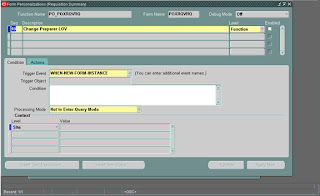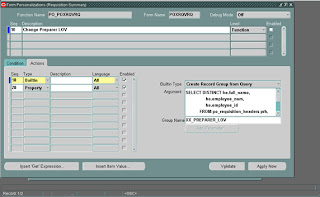Dest_Subinventory is an field which has to display when “Transaction Nature” IN Details tab value is “%SPARES”.
Restricting Dest_Subinventory to display on screen. (This requirement is not to display the Dest_Subinventory when we open the Requisition Form)
To Restrict the Dest_Subinventory field
Condition tab
Trigger Event - WHEN-NEW-FORM-INSTANCE
Actions tab
Seq Type Description Language
1 Property Subinventory not Displayed(You can give any meaningful) All
Object Type Item
Target Object LINES.DEST_SUBINVENTORY
Property Name DISPLAYED
Value FALSE
If Transaction_reason in (‘IMPORT – SPARES’,’LOCAL – SPARES’) THEN DEST_SUBINVENTORY SHOULD BE Displayed and the value should be ‘SPARES’
Condition Tab
Trigger Event – WHEN-NEW-ITEM-INSTANCE
Trigger Object – LINES.REFERENCE_NUM
Condition - :LINES.TRANSACTION_REASON IN (‘IMPORT – SPARES’,’LOCAL – SPARES’)
Processing Mode - Both
Action Tab
Seq Type Descritpion Language
9 Property All
Object Type - Item
Target Object – LINES.DEST_SUBINVENTORY
Property Name – DISPLAYED
Value - TRUE
Action Tab
Seq Type Descritpion Language
10 Property All
Object Type - Item
Target Object – LINES.DEST_SUBINVENTORY
Property Name – ENABLED
Value - TRUE
Action Tab
Seq Type Descritpion Language
11 Property All
Object Type - Item
Target Object – LINES.DEST_SUBINVENTORY
Property Name – VALUE
Value - =’SPARES’
Name - Transaction Nature – Regular
Once the Transaction Reason code is selected any one of the SPARES then DEST_SUBINVENTORY will displayed and again Transaction Reason code is selected any one of the REGULAR then DEST_SUBINVENTORY should not display.
So, We have created this Personalization.
If Transaction_reason in (‘IMPORT – SPARES’,’LOCAL – SPARES’) THEN DEST_SUBINVENTORY SHOULD BE Displayed and the value should be ‘SPARES’
Condition Tab
Trigger Event – WHEN-NEW-ITEM-INSTANCE
Trigger Object – LINES.REFERENCE_NUM
Condition - :LINES.TRANSACTION_REASON IN (‘IMPORT – REGULAR’,’LOCAL – REGULAR’)
Processing Mode - Both
Action Tab
Seq Type Descritpion Language
10 Property All
Object Type - Item
Target Object – LINES.DEST_SUBINVENTORY
Property Name – DISPLAYED
Value - FALSE
Action Tab
Seq Type Descritpion Language
10 Property All
Object Type - Item
Target Object – LINES.DEST_SUBINVENTORY
Property Name – DISPLAYED
Value - FALSE



















